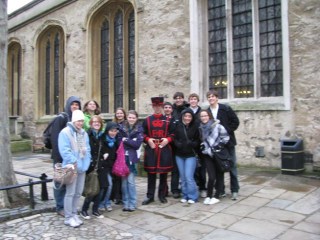 On Tuesday, we had the only time in our London stay where we could get to our destination with no transfers – the DLR line has a terminus at the Tower of London stop, so we were able to jump on the DLR and jump off, and then walk to the Tower. It was a nice change of pace.
On Tuesday, we had the only time in our London stay where we could get to our destination with no transfers – the DLR line has a terminus at the Tower of London stop, so we were able to jump on the DLR and jump off, and then walk to the Tower. It was a nice change of pace.
We met Deborah around 9:00 outside the Tower. This was to be the last tour Deborah would lead for us on this trip, and it was to be the longest – three hours long. As in the National Gallery (the art museum) and the British Museum, there was no way we were going to see everything in the amount of time we had. The Tower is very extensive, and three hours just gets you the highlights.
What surprises most people, me included, is that the Tower of London is not just a tower. It is a sprawling walled complex of buildings that is almost a small village. In fact, there are over one hundred people who live at the Tower to take care of it; many of these are the so-called “Beefeaters” who care for the Tower; their official title is “the Yeoman Warders.” The Tower was started in 1066 by William the Conqueror. He built a huge-for-the-time tower/fortress/palace that was almost one hundred feet tall, as a message to everyone in the area as to who was in charge. The monarchs who came after William continued to add to the structure. In its one-thousand-year history, the Tower has been a palace, a fortress, a prison, an arms depot, and even a zoo where the royal animals were kept until the London Zoo was founded. The Tower is now where the Crown Jewels are kept.
 Deborah took us in by a side gate where groups enter. The group entrance is on the Thames side of the Tower, and so offers great views of the Tower Bridge (the famous bridge everyone always thinks is London Bridge). We passed the private water gate that the kings used to use to get into the keep, and that later was used to transport prisoners in to the Tower from the river.
Deborah took us in by a side gate where groups enter. The group entrance is on the Thames side of the Tower, and so offers great views of the Tower Bridge (the famous bridge everyone always thinks is London Bridge). We passed the private water gate that the kings used to use to get into the keep, and that later was used to transport prisoners in to the Tower from the river.
We started our tour by touring the walls – I think it was the inner walls that we did, but I get a bit confused since you can see the Tower Bridge so easily from the walls. We got to look at the royal apartments for one of the early kings (I think it was Richard I), which were small and fairly basic. Deborah told us it would have been pretty well decorated and comfortable for the time. We then continued along the walls to another tower, where we got to see some very intricate graffiti that was carved by prisoners who were imprisoned in the Tower. Prisoners in the Tower were usually of high rank, and so while they were locked in the Tower, they were allowed access to the grounds during the day, and had fireplaces for warmth at night. Some of the highest ranking prisoners had small apartments where their families could visit or even stay. Many prisoners were locked up for years, but only twenty-three were killed in the actual Tower complex. It was more usual for executions to take place in public execution spots outside of the Tower. Anyway, some of the graffiti was of devotional aids to the Catholic priests who were locked in the Tower under Henry VIII and later Protestant monarchs.
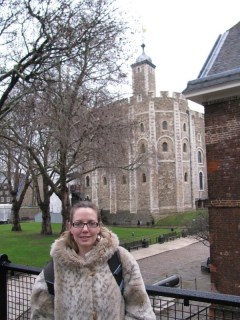 We moved on to go see the Crown Jewels. I’m not sure if it was because it was January or because of the weather (it had rained some right at the start of our tour), but the Tower had almost no tourists in it. It was amazing to have the place more or less to ourselves. Along the way to see the Crown Jewels, we stopped briefly to see some of the Tower ravens. There are eight ravens who live at the Tower and have their wings clipped in a special way so that they can fly, but not high enough to leave the Tower complex. They have a Warder who is in charge of caring for them, and they seem to be pretty spoiled. A gilded cage, perhaps, but a huge one. There is a superstition that as long as there are ravens living at the Tower, the monarchy will not fall. So, there are always ravens living at the Tower.
We moved on to go see the Crown Jewels. I’m not sure if it was because it was January or because of the weather (it had rained some right at the start of our tour), but the Tower had almost no tourists in it. It was amazing to have the place more or less to ourselves. Along the way to see the Crown Jewels, we stopped briefly to see some of the Tower ravens. There are eight ravens who live at the Tower and have their wings clipped in a special way so that they can fly, but not high enough to leave the Tower complex. They have a Warder who is in charge of caring for them, and they seem to be pretty spoiled. A gilded cage, perhaps, but a huge one. There is a superstition that as long as there are ravens living at the Tower, the monarchy will not fall. So, there are always ravens living at the Tower.
The Crown Jewels are kept in the middle of the Tower in a very secure area. The corridors are long and snake around to handle the massive summer crowds; we could have walked right in. We did stop at the two small areas showing film of coronations so we could see the Crown Jewels in use, and see close-up footage of the various jewels. We then walked in to see the jewels themselves. The area also has collections of robes and swords and gold tableware and such that are used for state purposes. The jewels are very impressive, with hundreds of diamonds and precious stones and the largest diamond in the world in the scepter the monarch holds during the coronation ceremony. To me, the display of huge solid gold tableware that was after the crown jewels was just as impressive. Mer and I laughed that we cannot even put together a matching set of glasses for guests, let alone set out a solid gold punch bowl.
We finished our tour of the Tower in the White Tower, which houses a museum of arms and armor, including three sets of armor belonging to Henry VIII, including a set made when he was in his fifties and was very fat. The museum is excellent, and has several interactive areas, so it was hard to keep the group together and moving through this section. As I said, three hours is not enough to tour the Tower. The White Tower also has a small chapel in it that is one of my favorite chapels in Europe – it is very small, but seems filled with peace.
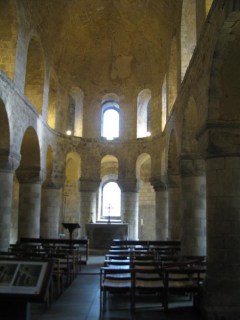 We finished our tour around 12:15 and said goodbye to Deborah. She had been a great guide, and I highly recommend her – you can reach her at http://www.tourist-guides.net/deborahcharles/ – if you are ever in London and want guide services, look her up.
We finished our tour around 12:15 and said goodbye to Deborah. She had been a great guide, and I highly recommend her – you can reach her at http://www.tourist-guides.net/deborahcharles/ – if you are ever in London and want guide services, look her up.
We were to end our last day in London at St. Paul’s. We took the Tube to the St. Paul’s stop and let the kids have a thirty-minute break for lunch. After we had reconvened, we took a tour of St. Paul’s. St. Paul’s is a very impressive cathedral – it is huge and open-feeling and is an architectural marvel of harmony and scale. This is the fifth St. Paul’s to stand on the spot; the fourth one, which was even bigger, burned down in the Great Fire of 1066. Christopher Wren, who at the time was a forty-five-year-old math professor at Cambridge, was asked to help rebuild London, including St. Paul’s. Christopher Wren lived to an astonishing-for-the-time age of ninety, so he lived long enough to see St. Paul’s finished, and he is one of the few people actually buried in the cathedral.
Our tour was led by an older man named Peter who was utterly charming. He had a patient and thorough way of speaking, and he went out of his way to engage the students. He asked one of the students to find the center of the church, which the student was able to do as it is marked with a huge seal under the massive dome of St. Paul’s (the dome, by the way, is the second largest in the world, with only St. Peter’s in Rome being bigger). He found out we had some Latin scholars among us, and he made them translate the Latin written on the great seal under the dome – when translated, it says, in part, “If you seek his [Wren’s] memorial, look about you.” Wren knew he had built something special.
Peter took us to the Quire, where the choir sings from, and let us sit in it. From there, we could admire the elaborate and colorful murals that were installed by the Victorians. Peter also pointed out the wood carving in the Quire, which he informed us were carved by a great wood carver, and in Peter’s opinion are the greatest carvings in the world. He may be biased, but they are very impressive and ornate. Peter also told us that Wren used clear glass in the cathedral when he built it, but stained glass had been installed over time. Then, in World War II, a bomb fell through the roof over the altar and exploded. The concussion blew out all the glass of the church, most of which ended up being replaced by clear glass again. A new altar was carved from wood, based on drawings that Christopher Wren had left (Wren’s altar had never been built because of the expense).
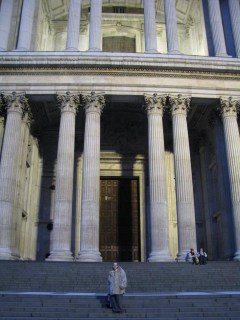 Peter then took us behind the altar, where the British built a small chapel honoring the Americans who died defending Britain. It is a touching, quiet place. The altar rail has several dates carved in it, and Peter quizzed us on them – I forget some of them now, but they included the date the first St. Paul’s was built, the date of the Great Fire, the date the current St. Paul’s was started, the date of the founding of Jamestown, and the date of the American Revolution. Peter quipped that the British do not mind the revolution – they are pleased when their children grow up and do well. He also pointed out the elaborate carvings in the American Chapel, which are all of native birds and plants, except for one well-hidden carving, which Peter pointed out. The carvings were made in the 1950s during the Space Race, so behind one of the vines carved on the altar is an American rocket, headed to the stars.
Peter then took us behind the altar, where the British built a small chapel honoring the Americans who died defending Britain. It is a touching, quiet place. The altar rail has several dates carved in it, and Peter quizzed us on them – I forget some of them now, but they included the date the first St. Paul’s was built, the date of the Great Fire, the date the current St. Paul’s was started, the date of the founding of Jamestown, and the date of the American Revolution. Peter quipped that the British do not mind the revolution – they are pleased when their children grow up and do well. He also pointed out the elaborate carvings in the American Chapel, which are all of native birds and plants, except for one well-hidden carving, which Peter pointed out. The carvings were made in the 1950s during the Space Race, so behind one of the vines carved on the altar is an American rocket, headed to the stars.
We finished our tour with Peter by going down into the crypts, which are also very airy feeling. He showed us the graves of Wren, Lord Nelson, and the Duke of Wellington (who helped win at Waterloo). We finished next to models of the current St. Paul’s and the older St. Paul’s that had burned in the Great Fire. As I said, Peter was a great tour guide.
It was then about 3:00, and we had to be back at St. Paul’s for the evensong service at 5:00. So, we let the students have free time until 4:45. Most used it to stay and explore St. Paul’s, including climbing the stairs of the dome. I had to run our rented cell phones over to a post office, which was one Tube stop away. Having done that, I went back to St. Paul’s. I decided to try to climb the dome stairs myself. I have a fear of heights, so while I like climbing things, I often do not like the results. The first climb of 257 steps takes you to the Whispering Gallery, which overlooks the space under the dome. It is about 100 feet up, and the Whispering Gallery is mostly open – it is a circular rim around the inside of the dome, with an iron guardrail. It scares me, but to get to the next set of stairs, you have to cross the gallery to the other side. I managed this by keeping my head down, in the process walking right by Meredith and several students who felt bad for me. By the way, it is called the Whispering Gallery because you are supposed to be able to whisper something on one side of the dome and be able to hear it on the other. Our students tried it with mixed success – sometimes it worked and sometimes you could not hear over all the other people whispering.
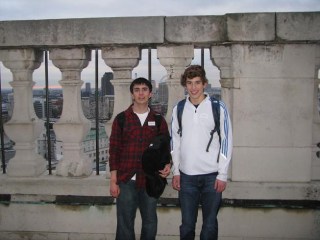 I charged on up the next set of stairs, 376 steps total (from the ground). This took me to the Stone Gallery, about 175 feet up. I liked the Stone Gallery. It was a wide balcony around the base of the Great Dome. It had high stone guardrails, and I could stay back from them a good ten feet or more. I was able to relax and enjoy the views, such as I could see through the railings.
I charged on up the next set of stairs, 376 steps total (from the ground). This took me to the Stone Gallery, about 175 feet up. I liked the Stone Gallery. It was a wide balcony around the base of the Great Dome. It had high stone guardrails, and I could stay back from them a good ten feet or more. I was able to relax and enjoy the views, such as I could see through the railings.
I eventually found the last set of stairs. These were hard. They were open spiral staircases between the inner dome (the one you can see inside) and the outer dome. It felt very exposed. I was scared and focused, so I missed a landing where you can look through a window from the top of the inner dome, all the way down to the great seal on the floor under the dome. I’m not too sad I missed that.
I got to the top of the stairs and saw what awaited me – a very tiny, unprotected circular balcony, 275 feet above the ground. I was terrified. I tried to turn around, but the people manning the door would not let me. The down stairs had to be used, and they were on the other side of the balcony. I would have to go out on the platform. I managed it because I had to and because I kept pressed up against the wall of the dome. People pretty much got out of my way – I think I looked pretty desperate. I got to the safety of the down-stairs door and fled inside. Next time, I’ll stop at the Stone Gallery.
Everyone met back up for the evensong service at 5:00. It lasted about an hour. It was very good, but I think I enjoyed Westminster’s evensong slightly better. The evensong choir at St. Paul’s was farther away than they had been at Westminster, so they were harder to hear. Also, they mostly sang in Latin, which was pretty but not intelligible to me. What was a good thing at St. Paul’s was that they had a short sermon, which is very unusual for an evensong service. It was excellent, too. It was honoring a Scottish woman, Mary Slessor, who had gone to Nigeria as a missionary in the late 1800s, where she was instrumental in promoting trade, establishing peace, and saving the lives of twins (who were believed to be cursed and were thus killed or abandoned at birth). The minister praised Mary for her willingness to go at a time when single women were not encouraged to go, and he used her as an example to all of us, as we should be willing to go and serve Jesus wherever we are and wherever we are called. It was an excellent exhortation.
The evensong service wrapped up about 6:00, and we let the kids have the last of their free time. They had to be back at the hotel by 9:00, and so they went their separate ways. Mer and I went to a burger place and ate there, then went back to the hotel. By happy luck, we ended up on the same train as three of our girls who were going back to the hotel early. So, we had company for the trip back. We got to the hotel about 7:30, but then Mer and I decided we needed dessert, so we ran back out to a store to pick up several Cadbury candy bars. We munched on those while we waited for everyone else to check in. Everyone did make it by 9:00, although several of the students seemed a bit winded. We found out later that some of them had even run. When one student asked why they were running, the others responded that they “did not want the Riordans to worry.” That was very touching to me and Meredith. What a great group. We do need to stress in the future that we would rather they not run so as to be safe, but it was still touching.
I did not get full details of what the various groups did, but I know one group went back to Trafalgar Square, and another went back to Oxford Street to go back to the huge toy store. It sounds as if they all had a good last evening in London. We encouraged the students to get to bed since we had to be up by 4:15 am to leave at 5:00. Mer and I were asleep (or at least in bed – sleep was sporadic) around 9:45.